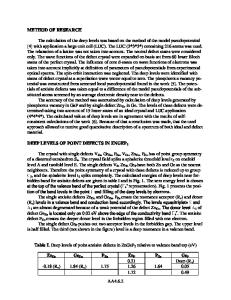Native Defect Characterization in ZnGeP 2
- PDF / 411,120 Bytes
- 6 Pages / 418.68 x 637.2 pts Page_size
- 58 Downloads / 407 Views
Abstract Electron paramagnetic resonance (EPR) as well as time-resolved and time-integrated photoluminescence (PL) are used to characterize the defect centers in ZnGeP 2 bulk crystals. The samples, as-grown, electron-irradiated and annealed, reveal a strong intensity dependence of the VZn-correlated EPR-transitions. Photo-EPR experiments show that this intensity behavior is mainly caused by a recharging of the VZn centers owing to the preparation induced shift of the Fermi-level. The luminescence spectra show a broad infrared emission with peak position at 1.23 eV that exhibits features of classical donor-acceptor recombination. The hyperbolic decay characteristics, investigated in energy range from 1.2 eV up to 1.5eV, suggest that this broad emission band is related to one energetic recombination center. This recombination is interpreted to be between donor-acceptor states related to residual disorder on the cation sublattice that is retained in metastable equilibrium during the formation of the chalcopyrite structure. The emission decay behavior in the energy range from 1.2 eV up to 1.6 eV is characterized by two hyperbolic time constants, and explained as the super-composition of the decays from the broad emission center peaked at 1.2 eV and an additional donor-acceptor recombination centers at 1.4 eV.
I.
Introduction Zinc germanium diphosphide (ZnGeP2) with a pseudo bandgap of - 2.1 eV at room tempera-
ture [1] has an attractive transparency range [2] from 0.67 pim to 13 pim and a relatively large second order susceptibility tensor component (d 3 6 = 75 pmnIV). Steady state photoluminescence (PL) studies revealed abroad peak maxima around 1.2 eV [3]. Time resolved measurements in the energy range between 1.2 and 1.6 eV show hyperbolic behavior which has been interpreted as donor-acceptor pair (DAP) recombination [4]. Higher energetic luminescence structures at 1.6 eV and 1.7 eV were revealed after annealing of ZnGeP 2 crystals. ZnGeP 2 grown under Ge-deficient condition by horizontal high pressure physical vapor transport (HPVT) show an additional emission structure at 1.8 eV and a sharp donor-acceptor emission at 1.778 eV associated with the presence of additional donor states. Electron paramagnetic resonance (EPR) measurements support the strong relation of the EPR signal with an acceptor band and restricted the possible nature of the defect related acceptor band to be either ZnGe sites or Vzn vacancies [5]. ENDOR-measurements 373 Mat. Res. Soc. Symp. Proc. Vol. 607 © 2000 Materials Research Society
reveal this centers as VZn vacancies [6]. From photo-induced EPR results on as-grown ZnGeP 2 crystals the deep luminescence emission is attributed to DAP transitions associated with Vp-Vzn pairs [7]. Most of the ZnGeP 2 crystals discussed in the literature are highly compensated and have a high concentration of donors and acceptors (1019 to 10 20 cm- 3). One possibility to reduce compensating defects is to anneal and irradiate the samples with electrons followed by reannealing. In this paper, we describe the
Data Loading...










